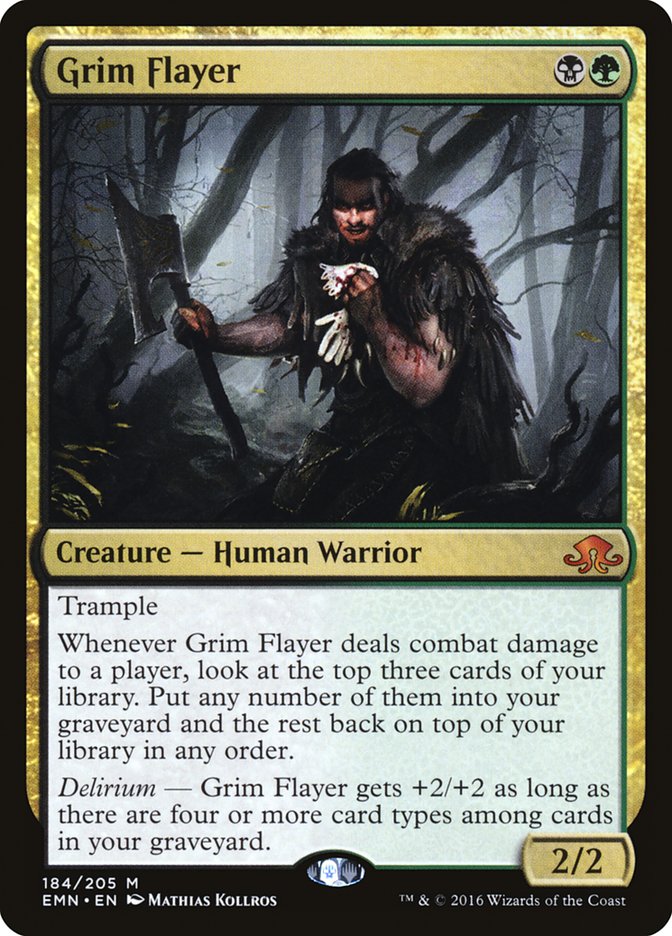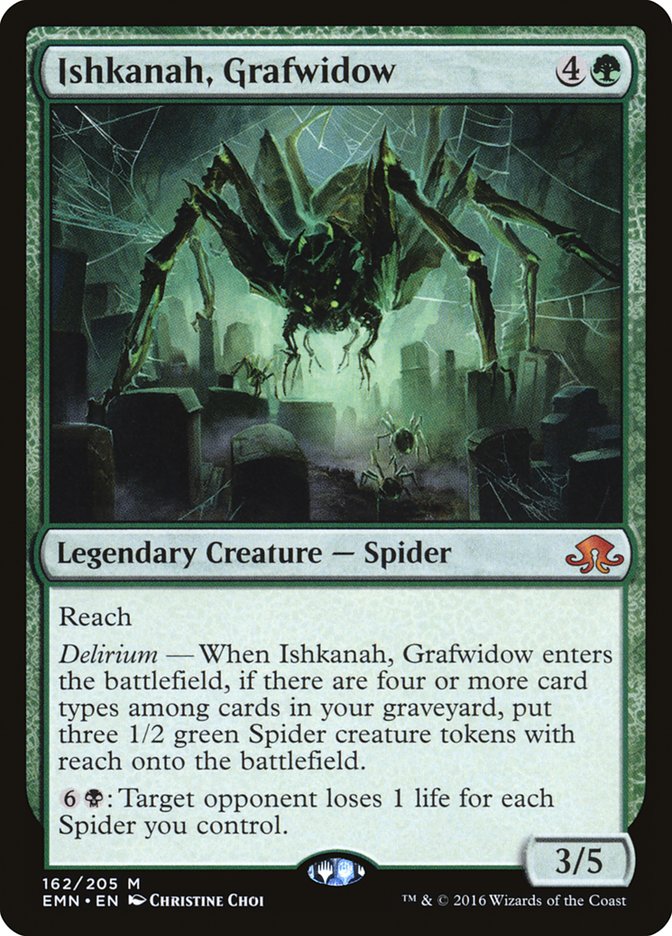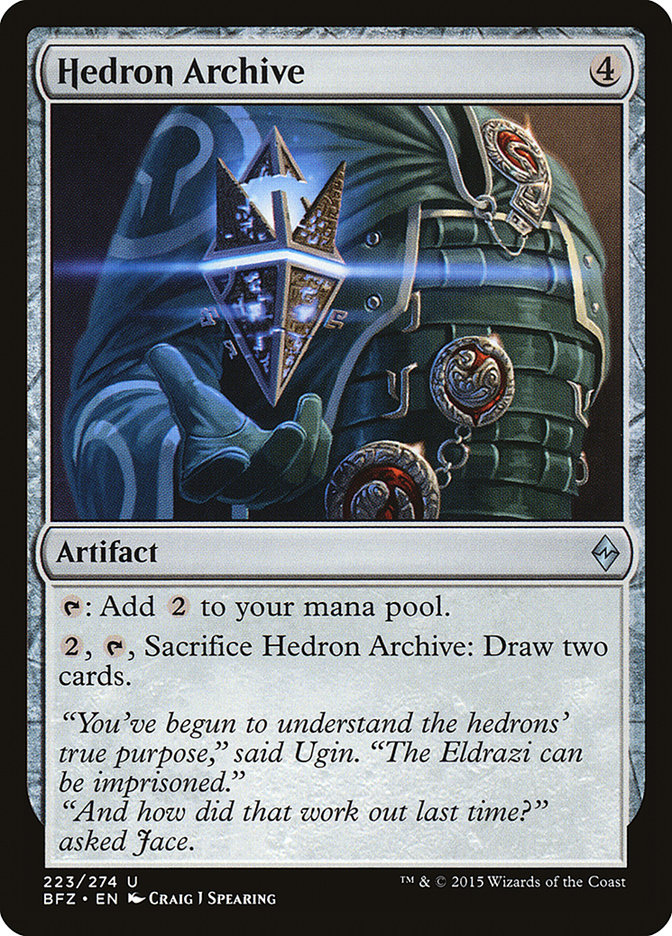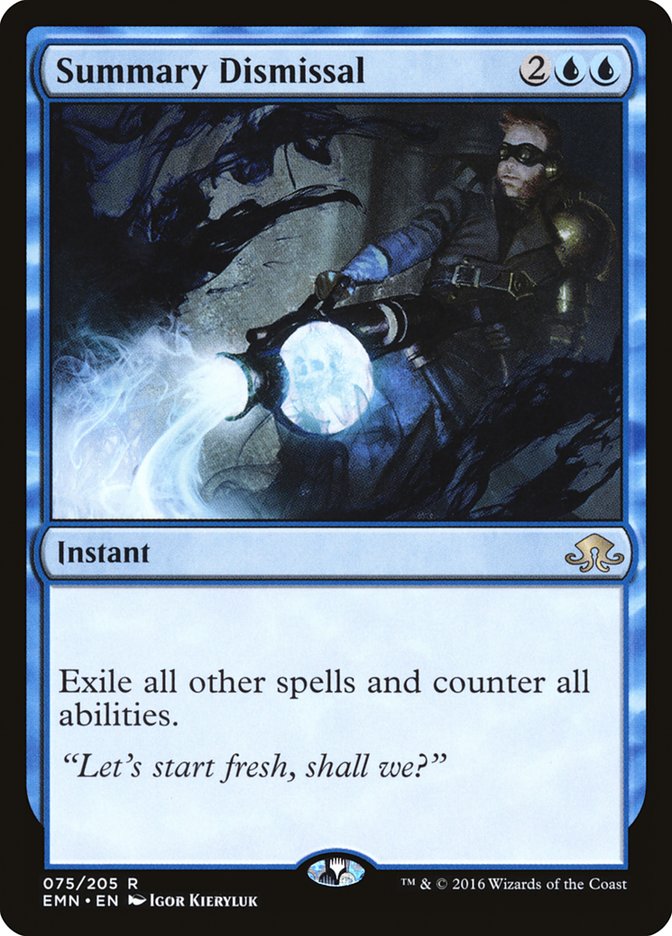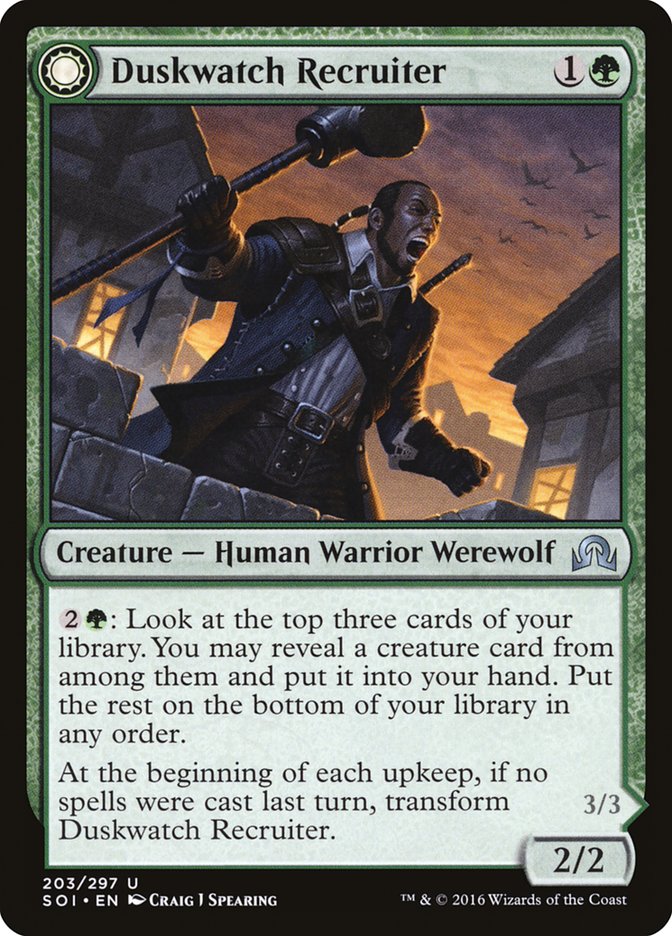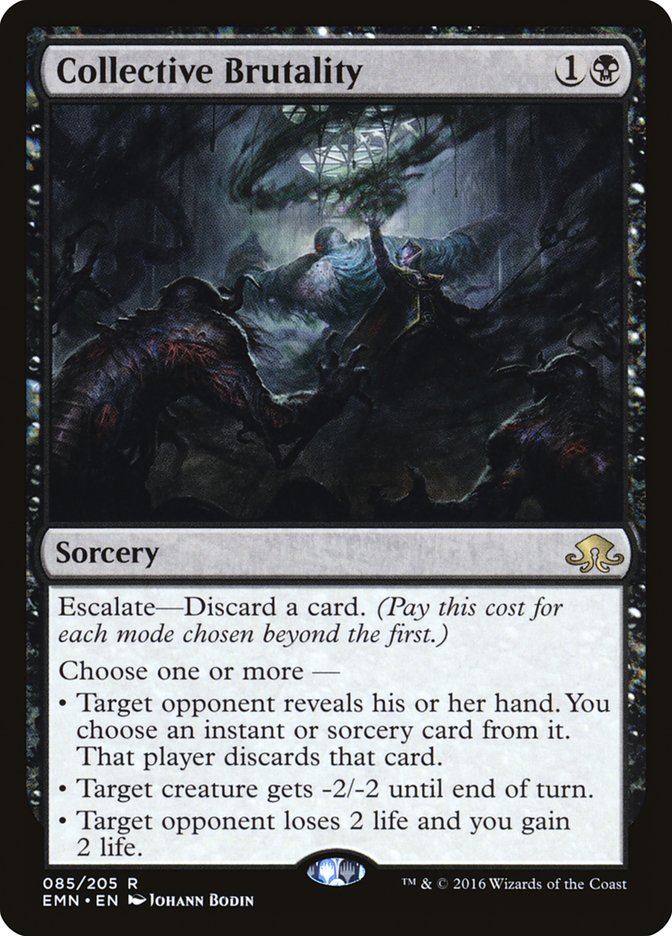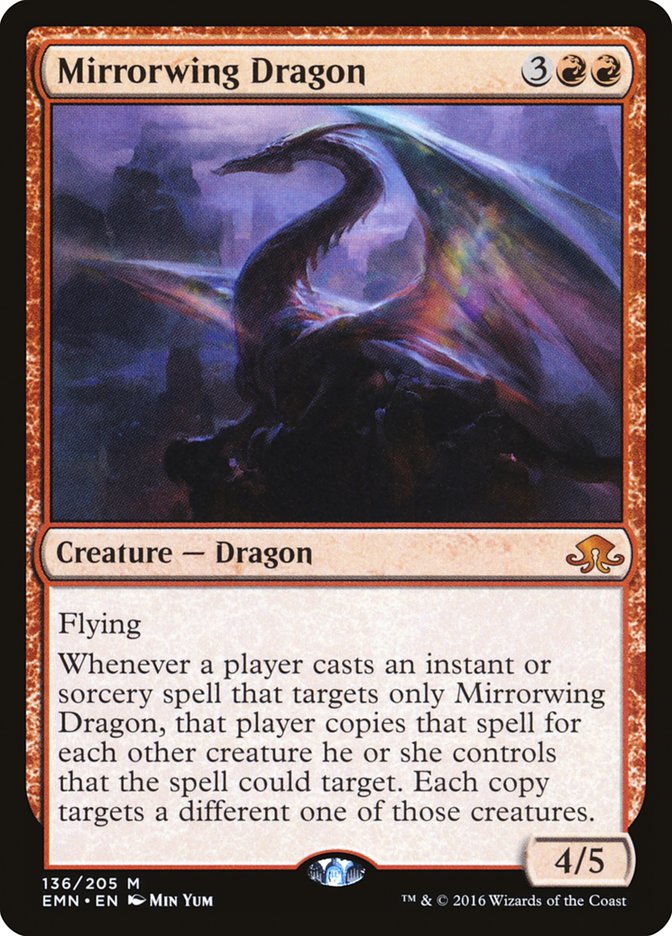#SCGCOL is in the books and the debut of Eldritch Moon was incredibly exciting, especially for those of you who like to put six mana worth of creatures onto the battlefield at instant speed for the low, low price of only four mana.
Ali Aintrazi’s Sultai Control deck was arguably the coolest of the tournament, but he was defeated in the finals by my Team Cardhoarder teammate Devin Koepke with our team’s build of Bant Company, designed by Andrew Tenjum.
Creatures (14)
- 1 Dragonlord Silumgar
- 2 Den Protector
- 4 Jace, Vryn's Prodigy
- 1 Nissa, Vastwood Seer
- 4 Sylvan Advocate
- 1 Emrakul, the Promised End
- 1 Ishkanah, Grafwidow
Planeswalkers (3)
Lands (26)
Spells (17)

How we got there, though, is an entirely different story.
I wasn’t going to be in Columbus for the SCG Tour® stop, but I was dedicated to the cause and spent quite a bit of time testing the new Standard format trying to find any new angles or face-down stones waiting to be flipped up at the right time.
The first place that I was happened to be G/B Delirium. Chris Andersen shared a list that he thought had merit and I latched onto it immediately. After only playing a handful of games I was positive that there was a lot of potential in the strategy.
I’ve talked about delirium a little bit before, but the more that I played with Grim Flayer and Ishkanah, Grafwidow, I came to realize just what the issues were with the previous delirium cards.
When we can get delirium incidentally just by playing Magic, then that’s awesome. Interacting with our opponents, digging through our deck, trading resources…all of these things are what we already want to be doing and just happen to get us to that point of delirium.
Grim Flayer is extremely serviceable even when we don’t have delirium as a 2/2 trample creature for only two mana, but it also facilitates getting to the powered-up point itself. Ishkanah, Grafwidow is less serviceable as a 3/5 for five, but with a mana cost of five, it’s likely that we can hit that delirium by the time we need to gum up the air and ground with a handful of spiders.
These are the cards and effects that we want as the payoffs. We don’t want our interaction cards to have delirium because, well, we want to be using those to interact to get to delirium.
The earliest versions of our G/B Delirium deck looked like this:
Creatures (20)
- 2 Hangarback Walker
- 4 Sylvan Advocate
- 4 Mindwrack Demon
- 3 Tireless Tracker
- 1 Emrakul, the Promised End
- 3 Ishkanah, Grafwidow
- 3 Grim Flayer
Planeswalkers (4)
Lands (24)
Spells (12)

A few things stood out right away from testing. First was that Ishkanah, Grafwidow was insane and every time I cast it I felt like there was no way that I could lose. Getting six power and eleven toughness, all with reach, out of four different creatures makes combat a nightmare for the opponent. There were multiple games that I won with the drain effect, and I found that getting to re-buy it with Den Protector or Liliana, the Last Hope’s -2 ability was awesome.
On the same note, Liliana, the Last Hope also overperformed.
She made combat a nightmare, threatened to kill smaller creatures out of decks like U/W Spirits and various Humans strategies, and did a very good job of reusing creatures like Den Protector and getting back Sylvan Advocate in long games where it’s a two-mana 4/5. The ultimate was about as game-winning as a three-mana planeswalker ultimate can be.
Emrakul, the Promised End is just that, the promised end to the game. It usually goes on for a few turns, but make no mistake, the game is over. We saw time and time again on coverage as Ali played his Emrakul and just demolished his opponents’ battlefields and gameplans.
You get an extra turn, but it’s more of a courtesy than anything else. Emrakul, the Promised End gives you a turn so that you die with your dignity, but you still die.
The one-cost dig spells were all right. I didn’t really want to be overloaded with Traverse the Ulvenwald, but having access to some number is paramount. Being able to get an Ishkanah, Grafwidow when we have delirium and produce four bodies out of nowhere was great, but using it to go find a land in the early-game feels pretty bad.
The removal mix was fine, but I did miss being on a maindeck Languish strategy, and I wanted more than the two that were in the sideboard of the initial build.
Den Protector was so good out of the sideboard that I wanted one in the main, and I also wanted some additional “value” creatures that we could find with Traverse the Ulvenwald and Vessel of Nascency and reuse with Liliana, the Last Hope and her -2 ability.
Here is the second version of the deck and where I stopped working.
Creatures (21)
- 1 Den Protector
- 1 Gilt-Leaf Winnower
- 1 Woodland Bellower
- 1 Kalitas, Traitor of Ghet
- 4 Sylvan Advocate
- 3 Mindwrack Demon
- 2 Tireless Tracker
- 1 Emrakul, the Promised End
- 3 Ishkanah, Grafwidow
- 4 Grim Flayer
Planeswalkers (4)
Lands (24)
Spells (11)

Gilt-Leaf Winnower did so much work for me in testing. Sadly it doesn’t hit Sylvan Advocate as the Advocate is an Elf in addition to the million other creature types that it has going for it, but it did snag a whole lot of creatures, from Tireless Tracker to Thalia, Heretic Cathar to the majority of the aggressive while creatures not having symmetry. The biggest, though, was Spell Queller. With Gilt-Leaf Winnower’s converted mana cost of five, it can’t be Spell Quellered and it can snag any opposing Spell Quellers that have quelled one of our spells.
Gilt-Leaf Winnower also kills Gisela, the Broken Blade; Bruna, the Fading Light; and Brisela, Voice of Nightmares — all of which I was able to do in testing — and it felt really good.
Woodland Bellower was just another way to grind out value if we needed to in sort of a Dragonlord Silumgar-type spot, but really, why not just try to play Silumgar?
I really liked this version of the deck and would have likely ended up on it for Columbus if I were going… That is, until Jacob posted a list of Sultai Control that he was working on. Unfortunately he didn’t do so hot in the event, but I still like a lot of what’s going on in his list and there are some definite parallels and progressions with Ali’s deck.
Creatures (13)
- 1 Dragonlord Silumgar
- 1 Den Protector
- 4 Jace, Vryn's Prodigy
- 1 Nissa, Vastwood Seer
- 1 Kalitas, Traitor of Ghet
- 1 Kindly Stranger
- 1 Emrakul, the Promised End
- 3 Ishkanah, Grafwidow
Planeswalkers (4)
Lands (24)
Spells (19)

Unfortunately, it came at the end of my helping out with testing for the event, but I thought that this deck looked absolutely sweet. Gaining access to Jace, Vryn’s Prodigy is great as he helps facilitate delirium for cards like Traverse the Ulvenwald and Ishkanah, Grafwidow, but he also plays very well with all of the spot removal at our disposal.
Jace and removal spells is nothing new, but helping turn on cards like Kindly Stranger and To the Slaughter is quite neat. You’ve also never really lived until you -2’d a Liliana, the Last Hope to get a Jace, Vryn’s Prodigy to cast it again.
Equally bombastic is getting back a Nissa, Vastwood Seer, casting her, and transforming her in the same turn.
Liliana may have only recently taken her oath and joined the Gatewatch, but she is right at home with these Magic Origins flip-walkers.
I absolutely love the direction that Ali took the deck in his second-place climb at #SCGCOL. Getting rid of the Vessels for Oath of Jace is great. I can also get behind cutting down on some Ishkanah, Grafwidow, but I think that I still would have two copies in the main, since it’s just so good against just about everything.
Hedron Archive does seems like an interesting addition, but the deck is very mana-hungry and it helps get us toward Emrakul, the Promised End either by producing colorless mana or jumping into our graveyard to add a card type and draw us closer to the end we are promising.
There are some “Ali Aintrazi” cards in the deck, like Scour the Laboratory and the Summary Dismissals in the sideboard, but I do like Painful Truths as a way to out-grind opposing control decks and the additional threats.
As much as we’re going to have to get used to Spell Queller doing its thing — and man, what were they thinking? — we’ll also have to get used to Emrakul, the Promised End doing her thing. She is very castable, and while you do have to put in some effort to get there, a lot of it is just playing Magic: The Gathering.
The last list I want to share is one that another teammate Joey ran across and figured out while we were testing. It actually felt pretty strong but had some consistency issues and we decided to focus our efforts elsewhere.
Creatures (29)
- 4 Prized Amalgam
- 4 Stitchwing Skaab
- 4 Elder Deep-Fiend
- 2 Voldaren Pariah
- 3 Wharf Infiltrator
- 4 Haunted Dead
- 4 Distended Mindbender
- 4 Cryptbreaker
Lands (24)
Spells (7)

This interesting number is looking to play one of two different gameplans. We can turbo out and chain together the emerge creatures, Distended Mindbender and Elder Deep-Fiend, by using our discard outlets and getting a Haunted Dead or Stitchwing Skaab onto the battlefield on the cheap for only two mana and some cards out of our hand. This route lets us take advantage of Kozilek’s Return and can also facilitate the other angle of attack.
Grind, baby, grind!
With Prized Amalgam, we can gain an absurd amount of value out of Haunted Dead and Stitchwing Skaab. Not only are we able to turn cards in our hand into multiple creatures, if those cards happen to be Prized Amalgam, we get insane value, and even if they are Kozilek’s Return, then we aren’t completely out whole cards.
Collective Brutality really pulled its weight, numerous times killing Duskwatch Recruiter and snagging a Collected Company out of my opponent’s hand on turn 2. Cryptbreaker and Wharf Infiltrator are very good at facilitating this grinding strategy too, but all of these things are quite fragile.
I got to live the dream a few times, using Haunted Dead, its 1/1 Spirit token, and a Prized Amalgam to transform a Voldaren Pariah, and while it does feel really good, it won’t happen often.
The deck is complicated but extremely fun to play.
Comments from Last Week
“Pretty sure ma and pa should be in the G/R tokens list“
– Travis Speth
I believe Travis is talking about Pia and Kiran Nalaar and I actually agree. While I don’t recall seeing the card when I played against a couple of different people on this type of strategy, it does seem like a great fit. It gives us three bodies for only four mana, and the artifact sacrifice ability is quite relevant, since that gives us a way to “break” our own Hangarback Walker.
With Thopter Engineer, we can even give those Thopter tokens haste and crash in on the same turn!
“I think a UR Dragons list is a much safer build to go instead of GR. It has counterspells and Icefall Regent which could be a better fight against flying things. And naturally it could also include some mono blue spirits itself!“
= Aydil Abdul Azis
I have never really been a huge fan of U/R Dragons, to be honest. Icefall Regent has also felt “weak” to me with its three toughness, although its mana taxing ability might be pretty relevant. If it also taxed abilities, then it would actually be pretty awesome, but as is it’s pretty vulnerable to Reflector Mage.
Mirrorwing Dragon is too, but it’s much easier to cast when we’re already wanting to get RR.
That being said, there is a lot to admire about a UU hard counter, and Silumgar’s Scorn is a card that doesn’t like to be kept down for too long.
Make sure to comment this week so that I have plenty of awesome comments to pick from for next week’s “Comments from Last Week” section.
I’ll be Baltimore this weekend doing commentary with Andrew Boswell for our last show of Season Two. Make sure you stop by and say hi if you are there, and good luck to everyone battling!


